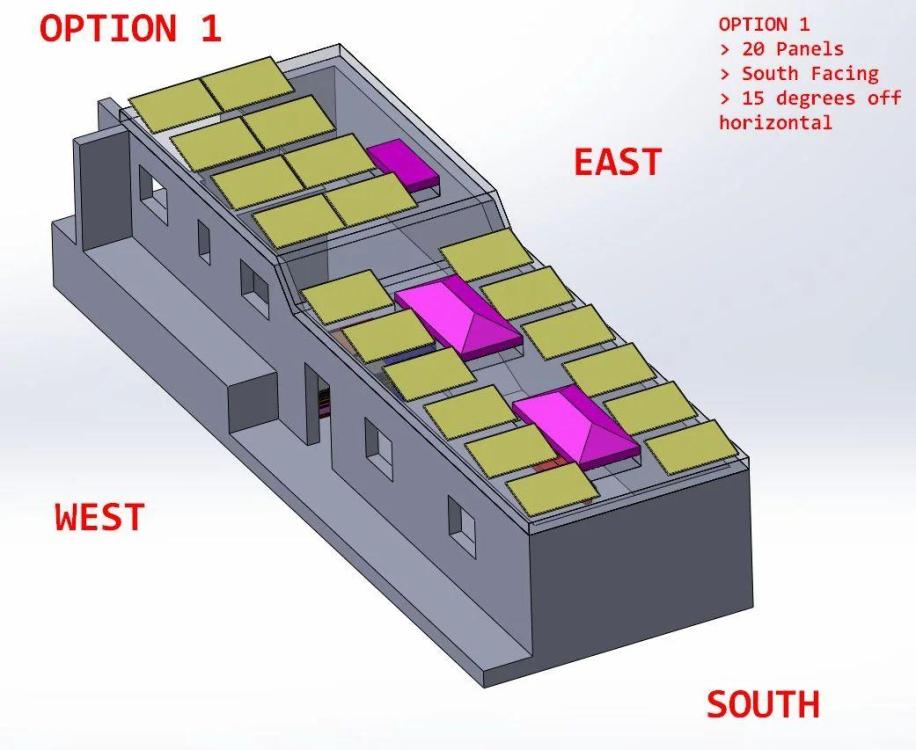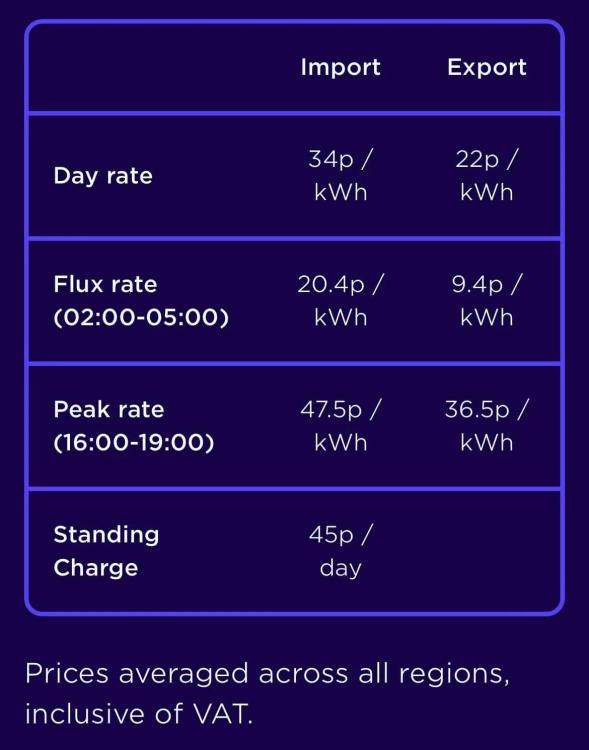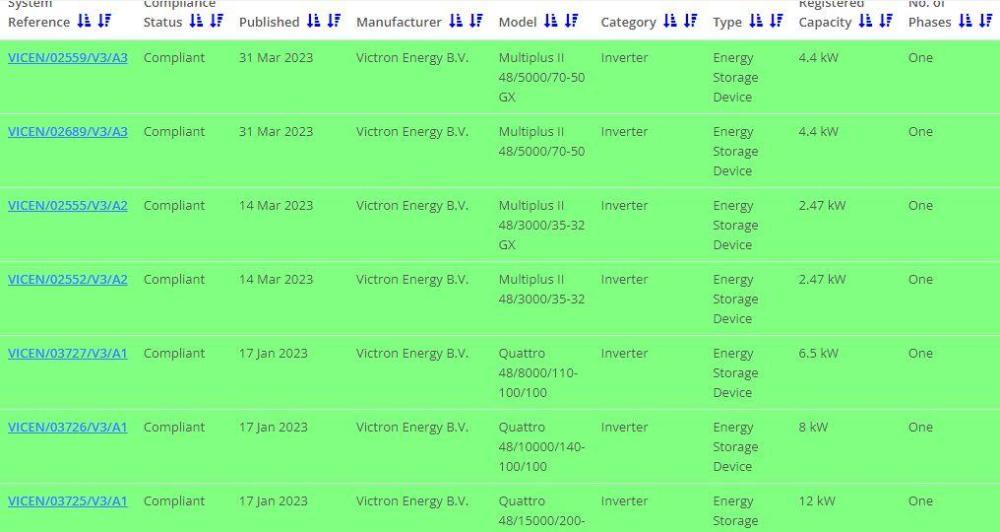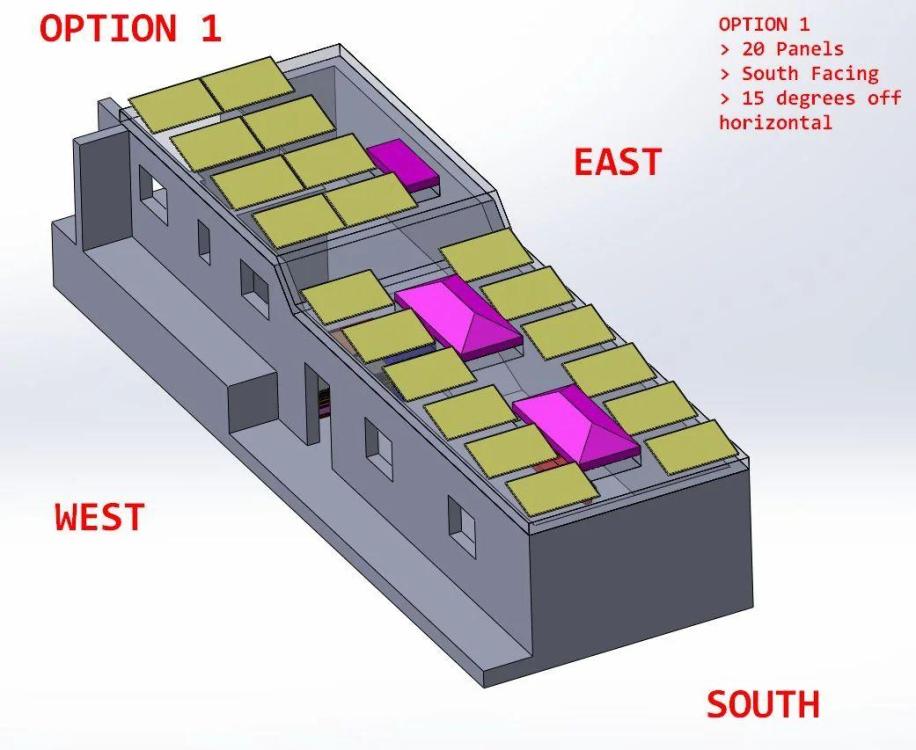-
Posts
55 -
Joined
-
Last visited
Everything posted by Smallholder
-

PV on a flat roof, how far from the edge?
Smallholder replied to Smallholder's topic in Photovoltaics (PV)
Sorry if I'm being a bit stupid here, but do these mounts need to be installed at the same time as the roof membrane? Or you can add them after the roof has been 100% finished? -

PV on a flat roof, how far from the edge?
Smallholder replied to Smallholder's topic in Photovoltaics (PV)
Ahh, I love the look of those Nicholson Plates! Thank you very much for the link, will definitely look into this. -

PV on a flat roof, how far from the edge?
Smallholder replied to Smallholder's topic in Photovoltaics (PV)
This is the layout I'm thinking about. I may be making life hard for myself in terms of wind lift, but I'd really like to use ballast rather than drilling a hundred plus holes through the roof membrane. You can see that with the existing roof and rooflights, leaving a sensible edge gap is not all that easy. Thanks for all the input folks, really appreciated. -

PV on a flat roof, how far from the edge?
Smallholder replied to Smallholder's topic in Photovoltaics (PV)
Thank you saveasteading I'd hoped there might be some solid formula I could follow, but maybe it's just down to my own risk appetite! -
I'm trying to get a new PV system installed, on a flat roof. I'm about to apply for planning permission, but can't find any solid info online about restrictions in terms of how far from the edge the panels must be. I assume this is a building regs thing rather than planning permission, but I'll need to be on the right side of both aspects I guess. Many websites seem to refer to a general rule of panels being at least a metre from the edge, which for my roof will massively reduce the area I can use. Does anyone else have any experience with this? Thanks in advance
-
VAT etc Am I missing a trick here, in terms of VAT? I understand that all kit involved in the new installation of a PV system is VAT zero rated, including batteries? So if I buy all the stuff myself, at a cost of say (very rough ballpark!) £15k inc vat, then I'm paying £2,500 in vat, that could potentially be saved and put towards an MCS registered installer doing the job. Not sure it makes any difference, but I am fortunate to have accounts with a couple of good suppliers that do panels, batteries, inverters etc. I guess there's no harm in getting a quote from an installer, and seeing how it compares to my equipment costs. There's also the point that I LOVE doing these jobs myself, and knowing how the kit works, how it went together etc. I wonder, roughly, what the export payments would be each year.
-
I was coming from the angle of trying to get paid to export, but if that's a no go (if we can't get MCS), then it would still be good from an environmental perspective. Even without getting any payment for feeding in, I'd be prepared to foot some additional expense in order to maximise what I feed in to the grid. Within reason.
-
I agree we are all kind of similar, as humans. But both my wife and I are self-employed, and we do not have any regular routine. Some days I am at home 23 hours out of 24, other times I'm not at home at all for a few days straight. There's also the point that our current consumption patterns are likely quite different to what the will be when we are generating our own power. Having been off grid at the farm for years, we have learned how to shift demand, but there is not such a great need for this at home beyond charging the EV's at night. It seems mad to design a system around a pattern that will change drastically.
-
Great info, thanks very much! I heard there is a bit of a faff in terms of which Victron inverters are approved for the G99 application, and from memory the bigger Quattro units are, but not sure about the larger Multiplus models. I'll have a look... Yes it looks like the largest Multiplus that's ENA approved is 5000VA (4.4kW). So in summer I'd not be able to export anywhere near as much as I'd need to.
-
Is that definitely the case? That Octopus would demand MCS cert? I had read online from people that had said they self installed, and were exporting to Octopus. Some of the year we would definitely be self consuming most or all of the power generated, but in the summer there should be a decent excess. Model shows over 1000kWh per month in summer, and only consuming 5-600kWh.
-
I have not yet gone this far with the consumption data, but I certainly could. Though our daily lifestyle is so unpredictable that I'm not sure I would get a lot from the data? I figured the battery storage almost covers a whole day of consumption, so that should set me on the right track... I'm just wondering what changes I might make to the suggested system, if I did have more detailed data? I guess I could reduce the number of panels if it somehow pointed towards that... The inverter I guess might want to change, but I'm not sure how I'd reach this conclusion. The inverter(s) I'm looking at would be a good size to ensure I could export at a sensible rate, and if needs be, charge from the grid off-peak. So I suppose the only thing I might be pointed towards, is changing the level of battery storage. Do you agree with this assessment?
-
I am certainly familiar with the kind of output I can expect, having relied on a 2.5kW PV system on our smallholding for the last few years. Yes I have modelled the output using this tool, so I have an idea of what to expect. It's a great tool! As I said in the post, and showed with the 3D model, this is really the max number of panels I can fit on the roof space available. I could just about get more panels on another roof, but figured there must be a law of diminishing returns that says beyond a certain point, the cost of the larger array doesn't really make sense. Plus it will cost more!
-
The update to our previous electricity tariff has given me the push I needed, to crack on with getting solar on our house. I've made off grid solar systems before, but never done anything grid tied, and never anything of this scale. So I'm not completely clueless, but also realise I have a lot to learn. Please go easy on me! The system I am planning will sit on a flat roof. Panels sitting at about 15 degrees. Thinking I'll use 20x 425W panels. The reason for this being, it's the max I can fit on the roof. Then I was thinking of using 3x PylonTech US5000 4.8kWh 48v batteries, and a Victron Quattro inverter (either 10,000VA or 15,000VA). I realise I'll need to go the G99 route. I'd ideally like to do 99% of the work myself. I'd like to export, so I'm keen to ensure my actions don't preclude this. I would like to create a system that can be configured to export at peak times. I realise I may not be able to export at the full inverter load. We currently have gas for DHW and heating, but interested in switching to electric. We have 2x EV's. Current we are consuming about 20kWh per day, with 50-60% of that off-peak (EV charging) So my questions are: 1 - Is it possible to install a system like this on your own. Not in terms of technical ability, but in terms of regulations etc. 2 - In term of the system spec, do you think I'm heading in the wrong direction with any part of the spec? 3 - Any advice in terms of the G99 form? I contacted 2 companies that advertised they they could help specifically with this part. 1 replied, and said that I should be fine to do the application myself. Many thanks in advance!
-

Getting started on the PV G99 (and G100) minefield
Smallholder replied to dnb's topic in Photovoltaics (PV)
I realise this is an old thread, but for anyone else wondering about G99 and G100 forms... G99 seems to be needed for proposed grid connected power generation systems up to 50kW and G100 for over 50kW. So almost all of us will be looking at G99 forms. -

Attempting a straw bale, off-grid passive house in Somerset
Smallholder replied to Smallholder's topic in Introduce Yourself
Quick update. We have our Design Review Panel meeting this morning. Fingers crossed.- 62 replies
-
- 1
-

-
- straw bale
- off-grid
- (and 8 more)
-
That sounds like a good setup. I wonder if it's possible to push the idea further, without running into problems. One of our red lines with this house build, is to be 100% off grid. Relying almost entirely on solar has it's limitations, and I'm wondering how clever we can be with it. I say almost entirely, as we've got a diesel generator, but I really only want to keep that for occasional emergency situations.
-
We've been doing endless calculations as part of our design for an off-grid home we are hoping to build. Energy storage is key to smoothing out the erratic energy produced from the large PV array, and it seems wise to try and use a large water cylinder as a secondary energy storage system as well batteries. Now this may well have been done before, but I had the idea of increasing the max allowable temp of the water in the hot water cylinder as a means of storing more energy when it's available. I have seen these clever little mixer valve things for public hot water taps. They have a hot water and cold water input, and they automatically mix the two to ensure that the output temp is never over 40 degrees C. Anti-scald valves I think they are called. Now we usually limit the temp of the water in the cylinder to about 60 degrees C, presumably to stop us burning the skin off our hands, and because we never need anything hotter than this coming out of the taps? If we allowed the water in the tank to be heated to, say 80 degrees... Could we then add a mixer valve on the hot water output of the cylinder, and mix to give the desired hot water output temp, say 60 degrees? This would allow a greater storage of energy in a given volume of water cylinder. Or maybe I am missing something, and it would be a foolish thing to do. Feedback appreciated.
-
We have decided to go down the paragraph 80 route, primarily as we are applying for planning permission for a house in open countryside. This is never an easy application to get approved, but we (rightly or wrongly) concluded that para 80 was our best bet. When we went to the local planning department and asked for pre-planning advice, they essentially said that they don't have the skills in house to be able to determine an application of this type and would basically sub-contract the decision (on whether the design meets the requirements set out in para 80) to a design review panel. From the reading I have done, it seems common for para 80 applications to include a design review panel. It also seems that the applications supported by approval from a design review panel are massively more likely to get planning approved. There is a member on here that went through a very similar process to the one we are going through now, and following a positive response from the DRP, was give planning approval. Does all this help, or am I missing the point a bit?
-
Thanks again, I'll do my best with all this! We've not yet set a date. The way the system works is that you get to the point you have everything in place that will be needed (including al the information you're supplying) then you book a slot with them. I'm hoping that we have everything in place by the 20th May (less than 2 weeks from now) and then book in. If we're requesting to present to them on site, then we request a specific date. In which case we'll aim for the first week in June. We're extremely fortunate to have a lovely site, and looks at it's best at this time of year. We have a good size off-grid solar array for power, and have 4G wi-fi. I will certainly present to an audience as a trial run. We hosted a presentation (about the proposed build) to a local sustainability group, so I've at least had some experience with presenting the material I'll be dealing with. As I said, I'll post on here with details of how we get on.







